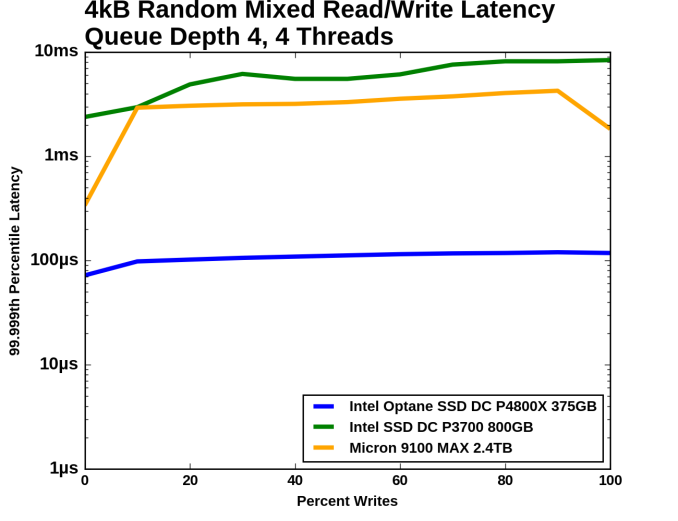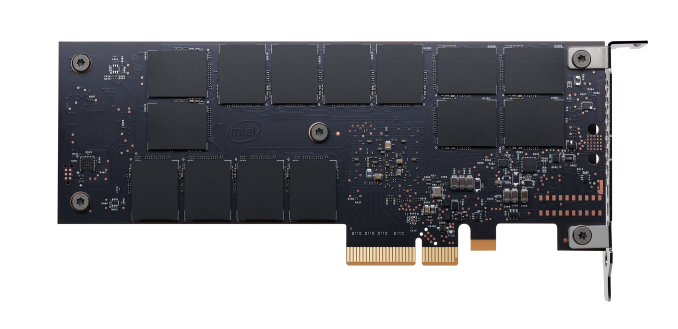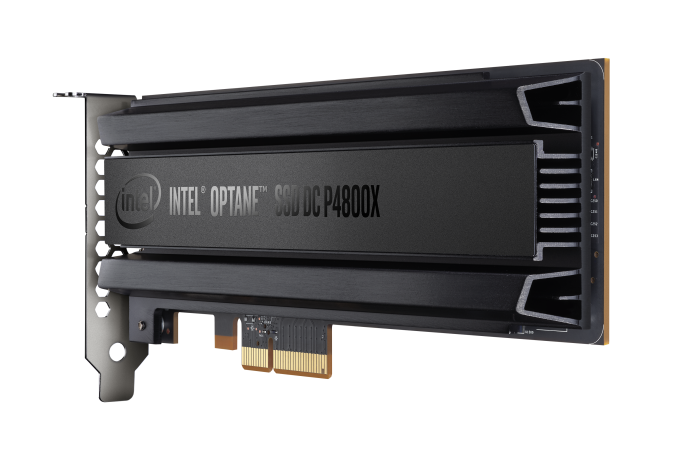The Intel Optane SSD DC P4800X (375GB) Review: Testing 3D XPoint Performance
by Billy Tallis on April 20, 2017 12:00 PM ESTFinal Words: Is 3D XPoint Ready?
The Intel Optane SSD DC P4800X is a very high-performing enterprise SSD, but more importantly it is the first shipping product using Intel's 3D XPoint memory technology. After a year and a half of talking up 3D XPoint, Intel has finally shipped something. The P4800X proves that 3D XPoint memory is real and that it really works. The P4800X is just a first-generation product, but it's more than sufficient to establish 3D XPoint memory as a serious contender in the storage market.
If your workload matches its strengths, the P4800X offers performance that cannot currently be provided by any other storage product. This means high throughput random access, as well as very strict latency requirements - the results Optane achieves for it's quality of service for latency on both reads and writes, especially in heavy environments with a mixed read/write workload, is a significant margin ahead of anything available on the market.

At 50/50 reads/writes, latency QoS for the DC P4800X is 30x better than the competition
The Intel Optane SSD DC P4800X is not the fastest SSD ever on every single test. It's based on a revolutionary technology, but no matter how high expectations were, very rarely does a first-generation product take over the world unless it becomes ubiquitous and cheap on day one. The Optane SSD is ultimately an expensive niche product. If you don't need high throughput random access with the strictest latency requirements, the Optane SSD DC P4800X may not be the best choice. It is very expensive compared to most flash-based SSDs.
With the Optane SSD and 3D XPoint memory now clearly established as useful and usable, the big question is how broad its appeal will be. The originally announcements around Optane promised a lot, and this initial product delivers a few of those metrics, so to some extent, the P4800X may have to grow its own market and reteach partners what Optane is capable of today. Working with developers and partners is going to be key here - they have to perform outreach and entice software developers to write applications that rely on extremely fast storage. That being said, there are plenty of market segments already that can never get enough storage performance, so anything above what is available in the market today will be more than welcome.
There's still much more we would like to know about the Optane SSD and the 3D XPoint memory it contains. Since our testing was remote, we have not yet even had the chance to look under the drives's heatsink, or measure the power efficiency of the Optane SSD and compare it against other SSDs. We are awaiting an opportunity to get a drive in hand, and expect some of the secrets under the hood to be exposed in due course as drives filter through the ecosystem.












117 Comments
View All Comments
Billy Tallis - Friday, April 21, 2017 - link
I said the NVMe driver wasn't manually switched into polling mode; I left it with the default behavior which on 4.8 seems to be not polling unless the application requests. I'm certainly not seeing the 100% CPU usage that would be likely if it was polling.If I'd had more time, I would have experimented with the latest kernel versions and the various tricks to get even lower latency.
tuxRoller - Friday, April 21, 2017 - link
I wasn't claiming that you disabled polling only that polling was disabled since it should be on be default for this device.Assuming you were looking at the sysfs interface, was the key that was set to 0 called io_poll or io_poll_delay? The later set to 0 enables hybrid polling, so the cpu wouldn't be pegged.
Either way, you wouldn't need a new kernel, just to enable a feature the kernel has had since 4.4 for these low latency devices.
Also, did you disable the pagecache (direct=1) in your fio commands? If you didn't, that would explain why aio was faster since it uses dio.
Btw, it's not my intent to unnecessarily criticize you because i realize the tests were performed under constrained circumstances. I just would've appreciated some comment in the article about a critical feature for this hardware was not enabled in the kernel.
yankeeDDL - Friday, April 21, 2017 - link
Optane was supposed to be 1000x faster, have 1000X endurance and be 10x denser than NAND (http://hothardware.com/ContentImages/NewsItem/4020...I realize this is the first product, but saying that it fell short of expectation is an understatement.
It has lower endurance, lower density and it is measurably faster, but certainly nowhere close 1000X.
Oh, did I mention it is 5-10X more expensive?
I am quite disappointed, to be honest. It will get better, but @not ready@ is something that comes to ind reading the article.
Billy Tallis - Friday, April 21, 2017 - link
3D XPoint memory was supposed to be 1000x faster than NAND, 1000x more durable than NAND, and 10x denser than DRAM. Those claims were about the 3D XPoint memory itself, not the Optane SSD built around that memory.ddriver - Friday, April 21, 2017 - link
It is probably as good as they said... if you compare it to the shittiest SD card from 10 years ago. Still technically NAND ;)yankeeDDL - Monday, April 24, 2017 - link
I disagree. I can agree that the speed may be limited by the drive, but even so, it falls short by a large factor. The durability and the density, however, are pretty much platform independent and they are not there by a very, very long shot. Intel itself demonstrated that it is only 2.4-3X faster (https://en.wikipedia.org/wiki/3D_XPoint).It clearly has a future, especially as the NAND is approaching the end of its scalability. Engineering wise is interesting, but today, it makes really little sense, while it should have been a slam dunk. I mean, who would have thought twice before buying a 500GB drive that maxes out the SATA for $20-30? But this one ... not so much.
zodiacfml - Friday, April 21, 2017 - link
It will perform better in DIMM.factual - Friday, April 21, 2017 - link
I don't see xpoint replacing dram due to both latency and endurance not being up to par , but It's going to disrupt the ssd market and as the technology matures and prices come down, I can see xpoint revolutionizing the storage market as ssd did years ago.Competition is clearly worried since seems like paid trolls are trying to spread falsehoods and bs here and elsewhere on the web.
ddriver - Saturday, April 22, 2017 - link
I just bet it will be highly disturbing to the SSD market LOL. With its inflated price, limited capacity and pretty much unnecessary advantages I can just see people lining up to buy that and leaving SSDs on the shelves.factual - Saturday, April 22, 2017 - link
You are either extremely ignorant or a paid troll !!! anyone who understands technology knows that new tech is always expensive. When SSDs came to the market, they were much more expensive and had a lot less capacity than HDDs but they closed the gap and disrupted the market. The same is bound to happen for Xpoint which performs better than NAND by orders of magnitude.